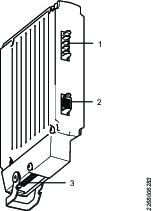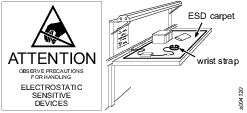Product Information
General Information
Safety Signal Words
The safety signal words Danger, Warning, Caution, and Notice have the following meanings:
DANGER | DANGER indicates a hazardous situation which, if not avoided, will result in death or serious injury. |
WARNING | WARNING indicates a hazardous situation which, if not avoided, could result in death or serious injury. |
CAUTION | CAUTION, used with the safety alert symbol, indicates a hazardous situation which, if not avoided, could result in minor or moderate injury. |
NOTICE | NOTICE is used to address practices not related to personal injury. |
Warranty
Product warranty will expire 12 months after the product is first taken into use, but will in any case expire at the latest 13 months after delivery.
Normal wear and tear on parts is not included within the warranty.
Normal wear and tear is that which requires a part change or other adjustment/overhaul during standard tools maintenance typical for that period (expressed in time, operation hours or otherwise).
The product warranty relies on the correct use, maintenance, and repair of the tool and its component parts.
Damage to parts that occurs as a result of inadequate maintenance or performed by parties other than Atlas Copco or their Certified Service Partners during the warranty period is not covered by the warranty.
To avoid damage or destruction of tool parts, service the tool according to the recommended maintenance schedules and follow the correct instructions.
Warranty repairs are only performed in Atlas Copco workshops or by Certified Service Partners.
Atlas Copco offers extended warranty and state of the art preventive maintenance through its ToolCover contracts. For further information contact your local Service representative.
For electrical motors:
Warranty will only apply when the electric motor has not been opened.
ServAid
ServAid is a portal that is continuously updated and contains Technical Information, such as:
Regulatory and Safety Information
Technical Data
Installation, Operation and Service Instructions
Spare Parts Lists
Accessories
Dimensional Drawings
Please visit: https://servaid.atlascopco.com.
For further Technical Information, please contact your local Atlas Copco representative.
Safety Data Sheets MSDS/SDS
The Safety Data Sheets describe the chemical products sold by Atlas Copco.
Please consult the Atlas Copco website for more information www.atlascopco.com/sds.
Country of Origin
For the Country of Origin, please refer to the information on the product label.
Dimensional Drawings
Dimensional Drawings can be found either in the Dimensional Drawings Archive, or on ServAid.
Please visit: http://webbox.atlascopco.com/webbox/dimdrw or https://servaid.atlascopco.com.
Overview
General information
The 3-phase tool connects to the FlexDrive.
Average power consumption
The FlexDrive will be overheated if average power consumption
|
Without fan |
Max 15 W / Drive |
|
With fan |
Max 30 W / Drive |
Normal Environmental Conditions
This product is designed to be safe under the following conditions:
Indoor use
Altitude up to 2 000 m
Operating temperature +5 °C / +41 °F to +50 °C / +122 °F
Storage temperature +5 °C / +41 °F to +50 °C / +122 °F
Maximum relative humidity 80 % for temperatures up to 31 °C / 89 °F decreasing linearly to 50 % relative humidity at 40 °C / 104 °F
Mains supply voltage fluctuations up to ±10 % of the nominal voltage
Transient overvoltages up to the levels of overvoltage category II
Temporary overvoltages occurring on the mains supply
Pollution degree 2
Ingress protection rating: IP54
Technical Product Data
Technical Product Data can be found on either ServAid, or the Atlas Copco website.
Please visit: https://servaid.atlascopco.com or www.atlascopco.com.
Accessories
Optional Accessories
QST tool cable
The QST tool cable can used to extend the PF6 FlexTool cable from the tool to the FlexDrive.
The maximum length of the combined FlexTool and QST tool cable is 60 m. Up to 8 cables (9 connections) are supported.
Length | Denomination | Article number |
|---|---|---|
2 m | QST tool cable | 4220 3799 02 |
3 m | QST tool cable | 4220 3799 03 |
5 m | QST tool cable | 4220 3799 05 |
7 m | QST tool cable | 4220 3799 07 |
8 m | QST tool cable | 4220 3799 08 |
10 m | QST tool cable | 4220 3799 10 |
Tool cable for FlexSystem
The FlexTool cable connects the tool with the FlexDrive.
The maximum length of the FlexTool cable is 60 m. Up to 8 cables (9 connections) are supported.

Length | Name | Remark | Article number |
|---|---|---|---|
1 m | Tool cable | PF6 Flex-QST 1 m | 4220 5272 01 |
1,25 m | Tool cable | PF6 Flex-QST 1.25 m | 4220 5272 11 |
1,5 m | Tool cable | PF6 Flex-QST 1.5 m | 4220 5272 12 |
2 m | Tool cable | PF6 Flex-QST 2 m | 4220 5272 02 |
3 m | Tool cable | PF6 Flex-QST 3 m | 4220 5272 03 |
5 m | Tool cable | PF6 Flex-QST 5 m | 4220 5272 05 |
7 m | Tool cable | PF6 Flex-QST 7 m | 4220 5272 07 |
10 m | Tool cable | PF6 Flex-QST 10 m | 4220 5272 10 |
15 m | Tool cable | PF6 Flex-QST 15 m | 4220 5272 15 |
Service Overview
Service Recommendations
Preventive maintenance is recommended at regular intervals. See the detailed information on preventive maintenance. If the product is not working properly, take it out of service and inspect it.
If no detailed information about preventive maintenance is included, follow these general guidelines:
Replace any defective or worn parts
Installation
Installation Requirements
FlexSystem compatible tools
FlexSystem is compatible with all QST tools up to 350 Nm, including dual transducer tools.
Installation Instructions
Connection interfaces

Pos | Connection |
|---|---|
1 | Connection to the FlexCarrier’s device slot, 400/480 VAC, protective earth. |
2 | Connection to the FlexCarrier’s device slot 24 VDC, ethernet, e-stop. |
3 | Connection to FlexTool cable. |
Install FlexDrive
Plug in the FlexDrive in a slot on the FlexCarrier.
Fasten the FlexDrive to the FlexCarrier with the screws. Wait to tighten it until all modules are fastened to the FlexCarrier.
Install tool
Connect the tool to the tool cable.
To avoid damaging connection pins. Line up the plug to the socket and ensure that the plug is parallel before insertion.

Plug in the tool cable.
Operation
Ergonomic Guidelines
Consider your workstation as you read through this list of general ergonomic guidelines to identify areas for improvement in posture, component placement, or work environment.
Take frequent breaks and change work positions frequently.
Adapt the workstation area to your needs and the work task.
Adjust for a convenient reach range by determining where parts and tools need to be located to avoid static load.
Use workstation equipment such as tables and chairs appropriate for the work task.
Avoid work positions above shoulder level or with static holding during assembly operations.
When working above shoulder level, reduce the load on the static muscles by lowering the weight of the tool, using for example torque arms, hose reels or weight balancers. You can also reduce the load on the static muscles by holding the tool close to the body.
Take frequent breaks.
Avoid extreme arm or wrist postures, particularly during operations requiring a degree of force.
Adjust for a convenient field of vision that requires minimal eye and head movements.
Use appropriate lighting for the work task.
Select the appropriate tool for the work task.
In noisy environments, use ear protection equipment.
Use high-quality inserted tools and consumables to minimize exposure to excessive levels of vibration.
Minimize exposure to reaction forces.
When cutting:
A cut-off wheel can get stuck if the cut-off wheel is bent or not guided properly. Use the correct flange for the cut-off wheel and avoid bending the cut-off wheel during operation.
When drilling:
The drill might stall when the drill bit breaks through. Use support handles if the stall torque is high. The safety standard ISO11148 part 3 recommends using a device to absorb a reaction torque above 10 Nm for pistol grip tools and 4 Nm for straight tools.
When using direct-driven screwdrivers or nutrunners:
Reaction forces depend on the tool settings and joint characteristics. Strength and posture determine the amount of reaction force that an operator can tolerate. Adapt the torque setting to the operator's strength and posture and use a torque arm or reaction bar if the torque is too high.
In dusty environments, use a dust extraction system or wear a mouth protection mask.
Service
Preventing ESD Problems
The components inside the product and controller are sensitive to electrostatic discharge. To avoid future malfunction, make sure that service and maintenance is carried out in an ESD approved work environment. The figure below shows an example of an appropriate service work station.

Maintenance Instructions
Service Recommendations
Preventive maintenance is recommended at regular intervals. See the detailed information on preventive maintenance. If the product is not working properly, take it out of service and inspect it.
If no detailed information about preventive maintenance is included, follow these general guidelines:
Replace any defective or worn parts
Recycling
Environmental Regulations
When a product has served its purpose it has to be recycled properly. Dismantle the product and recycle the components in accordance with local legislation.
Batteries shall be taken care of by your national battery recovery organization.
Recycling information

Pos | Part | Recycle as |
|---|---|---|
1 | Screws | Steel |
2 | Heatsink | Aluminium |
3 | Internal tool cable | WEEE |
4 | Plastic case | PA plastic |
5 | Brake chopper | WEEE |
6 | Base board | WEEE |
7 | Cover | Aluminium |